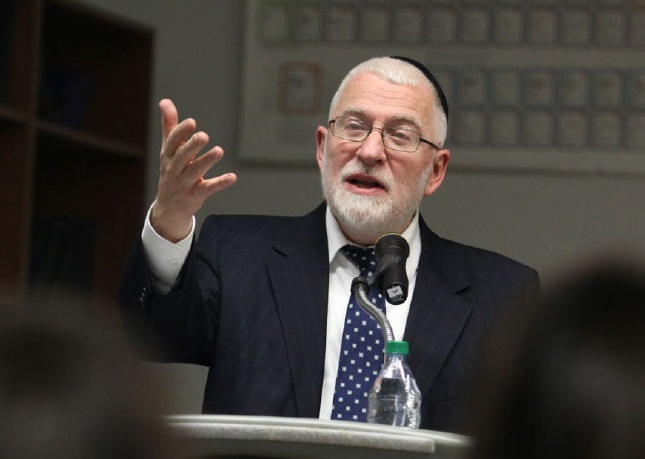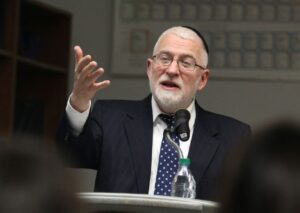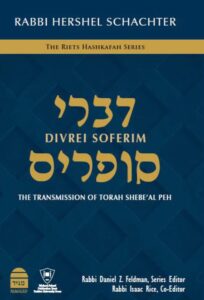PROFILE: The Faithful Transmission of the Oral Torah

Rabbi Hershel Schachter, Divrei Soferim: The Transmission of Torah Shebe’al Peh (Maggid Books & Yeshiva University Press), 184 pp.
 One of the most important principles of the Jewish is that the Torah consists of two equally vital parts: the Written Torah (Torah shebi-khtav) and the Oral Torah (Torah she-Be’al Peh) (see Rashi to Deut. 4:14). We owe a debt of gratitude to Rav Hershel Schachter for his newly released Divrei Soferim, which is devoted to an understanding of both the definition and the method of transmission of the Oral Torah.
One of the most important principles of the Jewish is that the Torah consists of two equally vital parts: the Written Torah (Torah shebi-khtav) and the Oral Torah (Torah she-Be’al Peh) (see Rashi to Deut. 4:14). We owe a debt of gratitude to Rav Hershel Schachter for his newly released Divrei Soferim, which is devoted to an understanding of both the definition and the method of transmission of the Oral Torah.
The Written Torah is generally understood as including the Five Books of Moses, Nevi’im, and Ketuvim. However, the Oral Torah is more challenging to define. In this work, R. Schachter presents a comprehensive introduction to the multiple facets of the Oral Torah, including the hermeneutical principles employed by the Talmud, and its relationship to the Written Torah. As the Talmud suggests, a deeper understanding of this relationship may even engender a more expansive definition of the Written Torah (Gittin 60b).
The Talmud records the story of the gentile who approached the great Sage Hillel to convert to Judaism but, not believing in the Oral Torah, only wanted to be taught the Written Law. Hillel proceeded to teach him the Hebrew alphabet beginning with “alef bet” and then the next day switched around the sequence of the letters to teach the prospective proselyte that mastery of Torah is impossible without an accompanying Oral tradition (Shabbat 31a). After all, who is to say what any symbol means absent an interpretive tradition? The same need for an appreciation of the Oral Torah’s foundation is required by students in each generation who seek to understand and acquire Torah knowledge.
The volume’s title, Divrei Sofrim, is a term that encapsulates the broad range of the landscape of Torah she-Be’al Peh. Rambam, the quintessential codifier of Jewish law, utilizes this phrase throughout his magnum opus, Mishneh Torah, to allude to different components of Oral Law: some that are considered to be within the framework of Torah-mandated law (see Maggid Mishneh, Hilkhot Ishut 1:2-3), and others that are considered to be within the framework of rabbinic law (e.g., Kesef Mishneh, Hilkhot Nahalot 1:8). Significantly, R. Schachter has undertaken the important task of clarifying the differences and lines of demarcation between Torah mandated laws (de-orayta) and rabbinic laws (de-rabbanan) within the larger context of the Oral tradition.
[Read the volume’s Introduction.]
R. Schachter masterfully reviews and expounds upon the five different components of the Oral Torah identified by Rambam: (a) official interpretations of the written law given at Sinai; (b) laws that were transmitted by God to Moses at Sinai but were not recorded in the written Torah; (c) the hermeneutical principles of Torah interpretation, also transmitted at Sinai; (d) rabbinic safeguards (“gezerot”); and (e) rabbinic enactments (“takkanot”).
However, R. Schachter does not stop there. He demonstrates the interconnectedness of the Written Torah and the Oral Torah through an analysis of the principle that Hazal enacted rabbinic laws in the manner and model of Torah law (Pesahim 30b). He elaborates upon the “development” of the Oral Torah, in terms of Rambam’s understanding that there is a need to apply Torah principles to new situations, and that this is a special power given to the Rabbis of each generation based on the principles of interpretation given at Sinai (41). In this regard, R. Schachter cites R. Moshe Shmuel Glasner, the author of Dor Revi’i, as declaring that Hazal’s statement, “Anything that a wise student will innovate in Torah was already given to Moses at Sinai” (Yerushalmi Pe’ah 2:4), represents an expression of the latent potential embedded in the principles given at Sinai with which future generations of Rabbinic scholars use to interpret the Torah.
 At the same time, R. Schachter places careful emphasis on the various passages in the Talmud (see Bava Metzia 86a) and in the works of later authorities (e.g., Kesef Mishneh, Mamrim 2:1) that spell out the idea of “hatimat ha-Talmud,” that it is prohibited for later generations to disagree with anything that had been decided by Hazal (see especially the comments of the Vilna Gaon, Bi’ur HaGra, H.M. 25:6). This principle is a core definition of Orthodox Judaism and serves as a linchpin of the faithful transmission of the Oral Torah.
At the same time, R. Schachter places careful emphasis on the various passages in the Talmud (see Bava Metzia 86a) and in the works of later authorities (e.g., Kesef Mishneh, Mamrim 2:1) that spell out the idea of “hatimat ha-Talmud,” that it is prohibited for later generations to disagree with anything that had been decided by Hazal (see especially the comments of the Vilna Gaon, Bi’ur HaGra, H.M. 25:6). This principle is a core definition of Orthodox Judaism and serves as a linchpin of the faithful transmission of the Oral Torah.
Divrei Soferim appears as part of the RIETS Hashkafah Series through the Michael Scharf Publication Trust of Yeshiva University Press and originated as a series of shiurim delivered for the Orthodox Union. As Director of RIETS Press, I have been privileged to be personally involved in both the initial work on this volume years ago, and in advocating for the inclusion of an additional chapter, based on an enormously popular shiur given by R. Schachter on the subject of apparent contradictions between the Oral Torah and science. This special chapter, presented as Appendix I to the volume (two additional appendices have now been added as well), synchronizes the previous summary of the different aspects of the Oral Torah with a contemporary case study of the parameters of immutability and development.
R. Schachter takes a refreshingly keen-sighted approach to the Torah’s attitude towards modern science in which he notes that Hazal relied upon the scientific authorities of their time, but also recognized that new discoveries and changes in scientific understanding could have ramifications on the application of immutable halakhic principles. In this vein, R. Schachter navigates the internal dynamics of the Oral Torah regarding when a particular law may no longer apply to a particular situation and when it remains in force. This nuanced parsing of immutable halakhic principles and commitment to scientific knowledge and reality shows respect for the integrity of both and charts a course for ongoing religious commitment in the modern world. For example, R. Schachter discusses the position of Hazon Ish that due to changes in science, a premature child born during the ninth month, who was viewed as non-viable during Talmudic times, is now viewed as viable from the standpoint of halakha.
Finally, and fittingly, the book concludes with a discussion of the meaning of “Masora,” the chain of teacher-student relationships that ensure the pristine preservation of the Torah traditions throughout the generations. This is a topic which R. Soloveitchik zt”l championed, and which R. Schachter has maintained a profound engagement with over his long career. In Divrei Soferim he provides the guidelines for finding the right balance between innovation and circumspection, between boldness and deference, in the process of formulating and deciphering halakha—both practical observance as well as how halakha shapes our worldview. A recurring theme in R. Schachter’s presentations to his students is the necessity for a halakhic authority to be qualified for the position, in terms of Torah knowledge, fear of God, and respect for rabbinic authorities of previous generations.
Thus, commenting on the passage in the Talmud stating that Yiftach in his generation had the same authority as Shmuel in his generation (Rosh Hashana 25b), R. Schachter is fond of quoting the wordplay in Yiddish folklore based on the verse pertaining to the hazards of an open pit, “ve-khi yiftah ish bor?” (Exod. 21:33) – “do you think Yiftach was an ignoramus?!” (see note on p. 56). It is an appropriate coda for this volume to remind the reader that while the study of Torah is meant for the entirety of the Jewish people, the ability to serve as a link in the chain of transmission of the Masora is reserved for the figures of great distinction (yehidei segula; ssee Vayikra Rabba 2:1). Not surprisingly, R. Schachter makes repeated mention in his last chapter of the need for gedolei ha-dor to serve as the central authorities in the transmission of Torah and in the approval of any innovations in practice.
As one of the gedolei ha-dor in our midst, R. Schachter is uniquely positioned to provide us with an authoritative explanation of the interplay between the principles of the transmission of the Oral Torah with the challenges of the modern world. When reading this book or listening to the thousands of his shiurim available online, one is also struck with the sentiment of “ha-devarim semehim ke-netinatan mi-Sinai” (see Shir Hashirim Rabba 1:10) – learning from Rav Schachter is so enthralling that it helps provide us with a glimpse of the Sinaitic experience.
According to the Midrash, God gave the Oral Torah to the Jewish people so that we would become exceptional through it (Bemidbar Rabba, 14). R. Hershel Schachter’s Divrei Soferim illuminates the unique splendor of our Oral tradition and our Masora and will inspire all its readers to soar to greater heights in Torah study and commitment.
Rabbi Yona Reiss, a member of the TRADITION editorial board, serves as the Av Beth Din of the Chicago Rabbinical Council.
